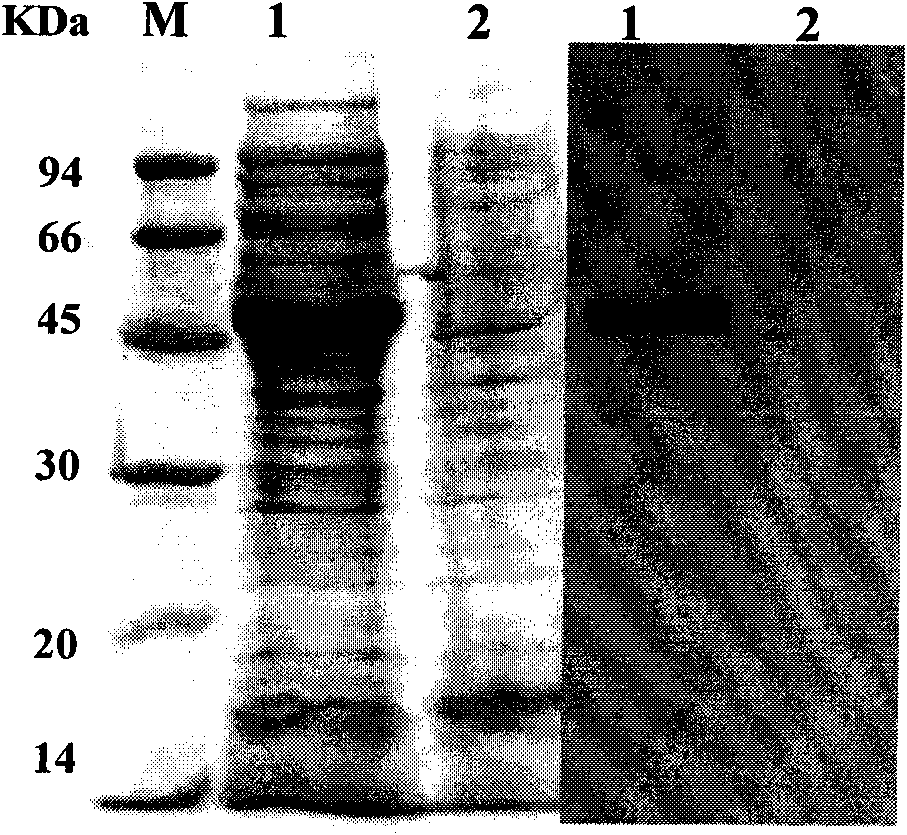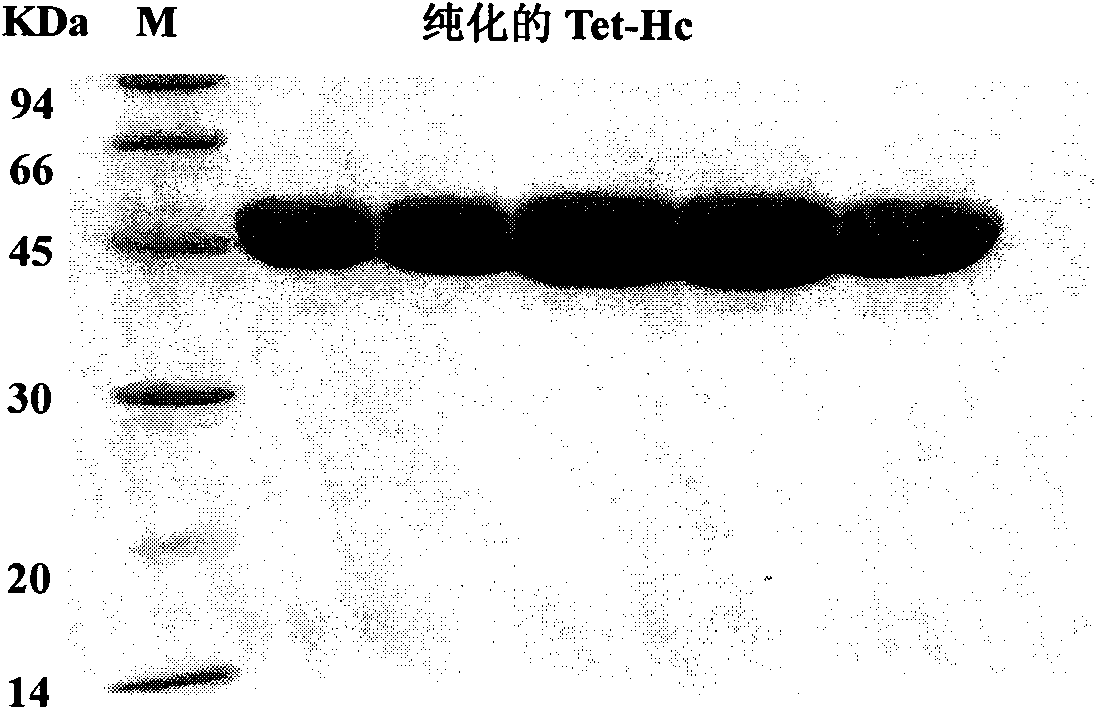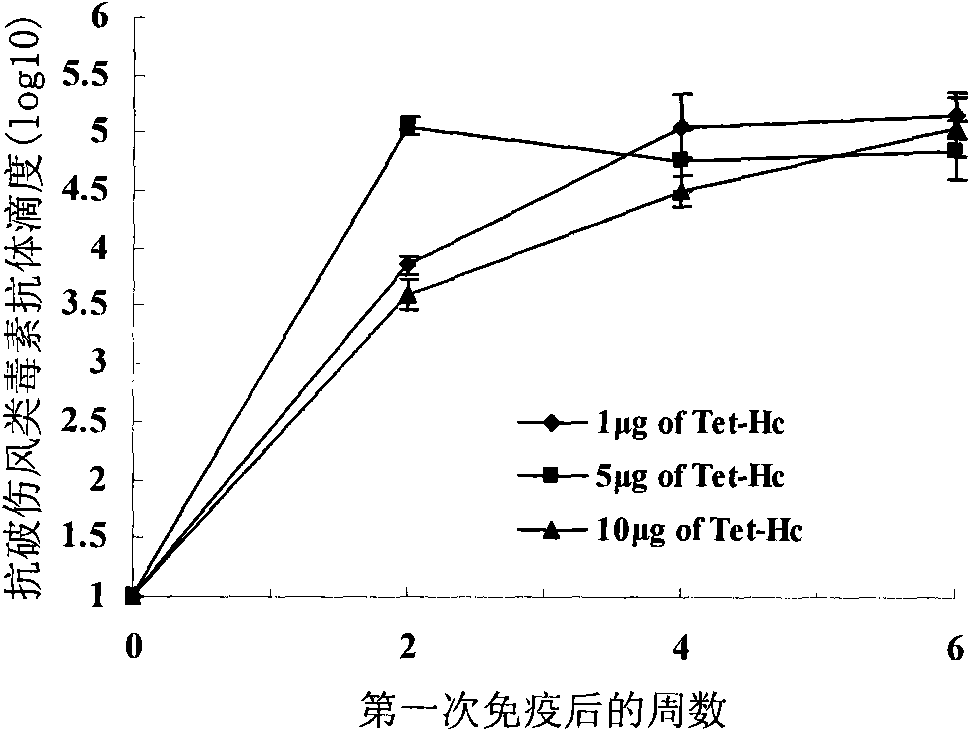High-level expression of tetanus toxin receptor binding domain Hc in Escherichia coli and application
A tetanus toxin-receptor binding technology, applied in the field of genetic engineering, can solve the problems of toxoid toxicity reversal, side effects, pollution, etc.
- Summary
- Abstract
- Description
- Claims
- Application Information
AI Technical Summary
Problems solved by technology
Method used
Image
Examples
Embodiment 1
[0038] Example 1. Sequence Optimization of Tetanus Toxin Subunit Vaccine Hc,
[0039] According to the sequencing results of 64008 virulent strains of Clostridium tetani C.Tetani in China (GeneBank sequence number: AF154828), the Tet-Hc sequence of 451Aa was analyzed and optimized (the sequence comparison before and after optimization is as follows), and the codons commonly used in Escherichia coli were replaced rare codons, and reduced the AT content of the optimized sequence from 72.57% to 52.47%. EcoRI and XhoI restriction sites were added to both ends of the Tet-Hc sequence, and a TAA stop codon was added before the start codon to terminate the expression of Trx protein on the vector pET32a(+), and the whole gene synthesis was carried out.
[0040] Comparison before and after Hc sequence optimization:
[0041] Before optimizationAAAAATCTGGATTGTTGGGTTGATAATGAAGAAGATATAGATGTTATATTAAAAAAGAGT
[0042] Optimized AAAAACCTTGATTGTTGGGTCGACAACGAAGAAGACATCGATGTTTATCCTGAAAAAGTCT
...
Embodiment 2
[0087] Example 2. Construction of Tetanus Toxin Subunit Vaccine Hc Expression Vector
[0088] After the optimized synthetic Tet-Hc gene was digested with EcoRI and XhoI, it was connected to the expression vector pET32a(+) which was also digested with EcoRI and XhoI, transformed into Escherichia coli competent cell DH5α, and cultured overnight at 37°C . The next day, single clones were picked and placed in 5 mL LB (Amp+) medium, cultured at 37°C, 220 rpm for 12 hours, plasmids were extracted, EcoRI and XhoI double enzyme digestion was performed to identify the insertion of the target gene, and sent for sequencing. The correctly sequenced plasmid was named pET32a-Tet-Hc. Example 3. Escherichia coli expression and western-blot identification of tetanus toxin recombinant subunit vaccine Hc
Embodiment 3
[0088] After the optimized synthetic Tet-Hc gene was digested with EcoRI and XhoI, it was connected to the expression vector pET32a(+) which was also digested with EcoRI and XhoI, transformed into Escherichia coli competent cell DH5α, and cultured overnight at 37°C . The next day, single clones were picked and placed in 5 mL LB (Amp+) medium, cultured at 37°C, 220 rpm for 12 hours, plasmids were extracted, EcoRI and XhoI double enzyme digestion was performed to identify the insertion of the target gene, and sent for sequencing. The correctly sequenced plasmid was named pET32a-Tet-Hc. Example 3. Escherichia coli expression and western-blot identification of tetanus toxin recombinant subunit vaccine Hc
[0089] The pET32a(+) vector correctly connected into the Tet-Hc gene was transformed into Escherichia coli competent cell BL21(DE3), and a single clone was picked and cultured in 5mL LB(Amp+) liquid medium at 37°C and 220rpm until OD600nm≌0.6 , adding IPTG with a final concentra...
PUM
 Login to View More
Login to View More Abstract
Description
Claims
Application Information
 Login to View More
Login to View More - R&D
- Intellectual Property
- Life Sciences
- Materials
- Tech Scout
- Unparalleled Data Quality
- Higher Quality Content
- 60% Fewer Hallucinations
Browse by: Latest US Patents, China's latest patents, Technical Efficacy Thesaurus, Application Domain, Technology Topic, Popular Technical Reports.
© 2025 PatSnap. All rights reserved.Legal|Privacy policy|Modern Slavery Act Transparency Statement|Sitemap|About US| Contact US: help@patsnap.com



